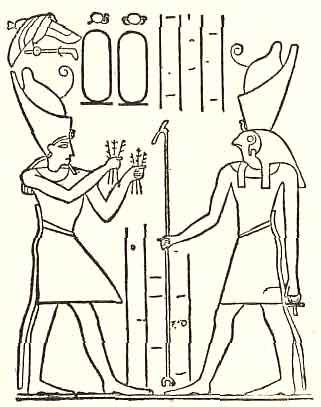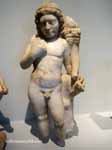.
Click Images to enlarge
Harpocrates, from the Isis Sanctuary of Dion, Greece. Dion Archaeological Museum
The child Horus represented to the ancient Egyptians the new-born Sun, rising each day at dawn.
When the Greeks conquered Egypt under Alexander, they morphed the Egyptian Horus into their Hellenistic god known as Harpocrates (in Egyptian Har-pa-khered or Heru-pa-khered meaning "Har, the Child").
Remember that the Egyptian written language, like those of the Semites, did not use vowels, so we can only conjecture what vowels fall where.

Alexander the Great, as King of Egypt and Horus
Horus was conceived by Isis, the mother goddess, from Osiris, the original god-king of Egypt who had been murdered by his brother Set (Typhon, or Chaos), and so became the god of the underworld. The Greeks melded Osiris with their underworld god, Hades, which thus became Serapis.
Horus fought vicious battles against Set, until he finally achieved victory and became the ruler of Egypt. All the Pharaohs of Egypt were seen as reincarnations of the victorious Horus.
Harpocrates, the child Horus, personifies the newborn sun each day, the first strength of the winter sun, and also the image of early vegetation. Egyptian statues represent the child Horus, pictured as a naked boy with his finger on his mouth.
"Upon her [Isis'] brow stood the crescent moon-horns, garlanded with glittering heads of golden grain, and grace of royal dignity; and at her side the baying dog Anubis, dappled Apis, sacred Bubastis and the god [Harpokrates] who holds his finger to his lips for silence sake." —Ovid, Metamorphoses 10.691.
In the Alexandrian and Roman vogue for mystery cults at the turn of the millennium (Mystery Cults which had existed for almost a millenium before), the worship of Horus was widely extended, linked with Isis (his mother) and Serapis (Osiris, his father). Inexpensive cast terracotta images of Harpocrates, suitable for house shrines, are scattered throughout the Roman Empire.
Modern occultists display his image, loosely connected now with Hermeneutic gnosticism. Typically, "Harpocrates is the Babe in the Egg of Blue that sits upon the lotus flower in the Nile. He is the 'God of Silence' and represents the Higher Self and is the 'Holy Guardian Angel'" and more in similar vein.
By the Egyptians the full-grown Horus was considered the victorious god of the Sun who each day overcomes darkness. He is often represented with the head of a sparrowhawk (as the hawk flies high above the Earth), which was sacred to him.
The Undefeated Sun (Sol Invictus) spread its cult widely throughout the Roman Empire, becoming the state religion under the emperors Heliogabalus, Aurelian, and even Julian.

Harpocrates, Thessaloniki Archaeological Museum
Reference
Franz Cumont, "The Oriental Religions in Roman Paganism," Dover Publications, 1956.
Harry Thurston Peck, Harper's Dictionary of Classical Antiquities, 1898: "Harpocrates."
David Sacks, "Language Visible: Unraveling the Mystery of the Alphabet," Random House 2003.
Figurine of the God Harpocrates
See also : Greek Mythology. Paintings, Drawings
| Ancient Greece
Science, Technology , Medicine , Warfare, , Biographies , Life , Cities/Places/Maps , Arts , Literature , Philosophy ,Olympics, Mythology , History , Images Medieval Greece / Byzantine Empire Science, Technology, Arts, , Warfare , Literature, Biographies, Icons, History Modern Greece Cities, Islands, Regions, Fauna/Flora ,Biographies , History , Warfare, Science/Technology, Literature, Music , Arts , Film/Actors , Sport , Fashion --- |
Retrieved from "http://en.wikipedia.org"
All text is available under the terms of the GNU Free Documentation License



